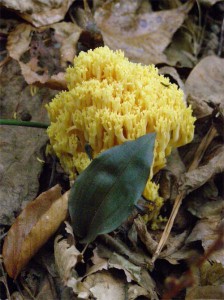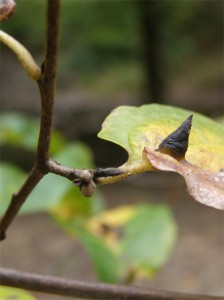Celebrating Bolin Creek

crane-fly-orchid-leaf-with- Winter leaf of crane-fly orchid emerges next to a coral fungus along the edge of Bolin Creek in the Adam’s tract nature preserve. Photo by Ken Moore.
By Ken Moore
It’s fall, and we have a winter’s worth of exploring along Bolin Creek ahead of us. I took my own solitary preview walk last Sunday.
My favorite access begins at the well-marked trailhead in Wilson Park that enters the Adams Tract nature preserve. An uphill walk through mature piney woods leads on over the oak-hickory forest and down through the beech-maple forest to the edge of the creek. All along the way, I could not help but pause frequently to admire mighty specimens of pine, oak, tulip poplar, beech and maple, each with an interesting story to relate, if only we knew how to talk to trees.
Well-worn trails lead in all directions along the creek’s corridors and on up into the Carolina North trails. It’s a close-to-home adventure to see if you can get yourself lost in these hundreds of acres of connected forests. If you succeed, you are never far from a trail that leads to a road or adjacent residential community.
It was a difficult choice Sunday for me to abandon enjoying the colorful wildflowers and grasses of fields and roadsides to enter the darker world of the forest. I was rewarded in rediscovering the beauty of fall’s lively awakening in so many ways.
The presence of so many different types of fungi (mushrooms) hugging the forest floor and clinging to fallen and standing trees reminded me that my mushroom guide was of little help left unattended on an indoor bookshelf. I took extra time out to appreciate a clump of coral fungus, so appropriately named for its underwater look-alike. This particular one seemed affectionately accompanied by the leaf of a crane-fly orchid, newly emerged for its seasonal growth to take advantage of the winter sun soon to be streaming through the leafless forest canopy. Numerous coral fungi are scattered about the forest floor. Some are edible and some are poisonous, so, unless you are an expert, enjoy with your eyes, but don’t touch.

witch-hazel-leaf-and-buds The little witch’s hat insect gall is a tell-tale mark of a witch hazel leaf. Photo by Ken Moore.
I was surprised to see a few flowers of the witch hazel already open. They usually wait until closer to December. The leaves are just beginning to take on their beautiful golden-yellow tints, and a lot of them sported those characteristic little witch’s hat-shaped insect galls perched on the leaf’s upper surface. You can always identify a witch hazel if you find those little witch’s hats, because that particular insect lays its eggs only on the leaves of witch hazel.
We are fortunate here in our Piedmont that fall’s awakening goes on and on for weeks. It’s as exciting as springtime, with something new to discover with each trek outdoors. A great companion to help you appreciate the diversity and brilliance of our local fields and forests is Fall Color and Woodland Harvests, an easy-to-use visual guide to tree colors and nuts and berries by C. Ritchie Bell and Anne Lindsey.


Comments are closed.